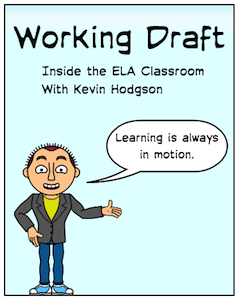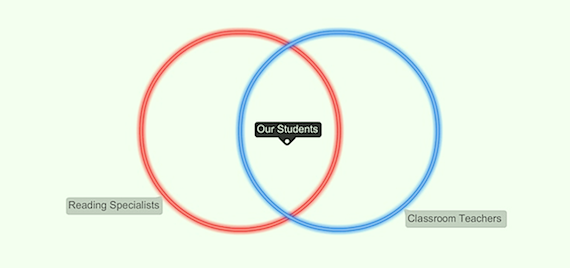Reading Intervention: The Outsider, Looking In
A MiddleWeb Blog
During the first professional development days of school this year, I took part in a group that allowed me to see our school community through a very different lens than I am used to.
This story requires a little context: our school district is moving into an entirely new math curriculum, so a publishing representative was brought in to introduce teachers to the new math program. A significant number of us don’t directly teach math, so we were shuffled around to various smaller groups for work around the theme of Professional Learning Communities. As an ELA teacher, I went with a group of reading intervention teachers from the elementary schools in our district.
Now, I teach reading to all of the sixth graders in my school. But the interventionists’ world of reading, with all of the various research-based programs and tongue-twisting acronyms, is vastly different from my world of reading, as a classroom teacher. (I wrote about my identity crisis in a K-6 school last year.)
These interventionists were thoughtful and well-steeped in the teaching of reading, and I spent the day feeling a bit like an outsider, looking in. The goal of the group was to continue a Professional Learning Community that had sprung up last year, thanks to their own advocacy and the support of one of the building principals, and now I am part of their PLC.
Dancing a different step
But I felt out of step, though this was not through any fault of theirs or my own. These interventionists have their own agenda and ideas. They also have their own struggles, brought on by administrators and classroom teachers, not to mention their primary mission to meet the daily needs of struggling learners.
It’s not that they are at odds with my own goals. We all want our students to be reading at grade level with understanding and love of texts. But I realized I have a lot to learn from them about strategies for reaching all of my readers, at all levels. And maybe I can bring some of my own classroom perspectives to the table? I sure hope so. During the course of the year, we intend to talk about case studies of student readers, share a book study, and more.
I learned a lot from listening
Unlike many other gatherings that I take part in, I kept my mouth mostly shut during the day – listening, absorbing, understanding. I took in their concerns:
► Classroom teachers don’t always turn to them for advice even though they are trained as experts in reading.
► Their data analysis on student learning sometimes gets ignored or shuffled aside.
► Administrators don’t make time for interventionists to meet with classroom teachers to talk about individual students who are struggling and how to help support those readers.
► Scheduling direct intervention time is a logistical nightmare.
► Their field of reading has so many programs that it can be difficult to discern the right one for a specific child. They juggle many approaches and adapt as necessary.
The work these interventionists do around supporting reading and literacy is so important, for students and for us, the classroom teachers. And yet they often feel isolated from the larger teaching community. They can even be seen as a hindrance when they take students out of content-instruction for one-on-one reading intervention.
I found myself viewing our school community through a slightly different lens, reflecting more deeply on all the various pieces that are often in motion. And I discovered yet again a new appreciation for the work of my colleagues whose professional practice often unfolds in small rooms around the school, day in and day out with the neediest of children.






































Thanks, Kevin. I’m a former teacher with two kids and I publish books for struggling readers. I’ll be very interested to read about your ongoing work with this PLC.
Steve,
Thanks for dropping by and leaving a note. Yes, I will try to share when I can about how our group is faring. So far, so good. We are doing a shared reading together and right now, everyone is gathering materials for a small lesson on how to use picture books to introduce a comprehension strategy along the spectrum of reading.
Kevin